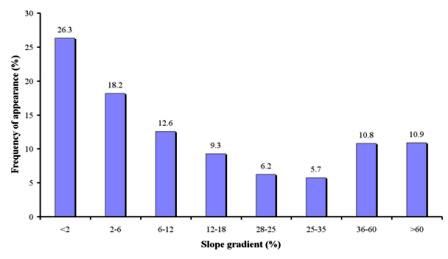Slope gradient
Slope gradient greatly affects the amount of surface run-off and soil sediment loss. Soil erosion rates become acute when slope angle exceeds a critical value and then increases logarithmically. Studies conducted in the island of Lesvos (Greece) have shown that soil erosion was moderate or high in slope gradients greater than 12%. Slope gradient can have variable effect in different climatic zones, depending mainly on annual rainfall. Generally, soil sediment loss can be estimated by the product of the amount of surface run-off times the slope gradient times a constant related to soil surface characteristics. As the slope becomes steeper, the runoff coefficient increases, the kinetic energy and carrying capacity of surface water flow becomes greater, soil stability and slope stability decreases, and soil sediment loss increase. Therefore, slope gradient is undoubtedly considered as one of the most important determinants of soil erosion and desertification in hilly areas, when they loose their protective vegetation.
Data for this indicator were collected in 1239 field sites, corresponding to 14 study sites (Table 3). As Fig. 21 shows, 26.3% of the total study fields were almost flat with slope gradient less than 2%. Such areas have been described in all study sites except Santiago Island-Cape Verde. Extensive plain areas have been identified mainly in Guadalentin Basin Murcia-Spain. And in Novij Saratov-Russia study sites. Gently sloping (2-6%) field sites is the following important class (Fig. 18) covering 18.2% of the study field sites. Such slope gradients have been measured in all study field sites. Moderately sloping areas (6-12%) have been described in 12.6% of the study field sites. Such slope gradients have been measured in all study sites except for Djanybek-Russia, Novij Saratov-Russia, and Konya Karapinar plain-Turkey. Strongly sloping areas (12-18%) have been found in all study sites except for Djanybek-Russia, Novij Saratov-Russia, and Konya Karapinar plain-Turkey, covering 9.3% of the total field sites. Moderately steep (18-25%) to steep (25-35%) slopes occupy 6.2% and 5.7% of the study sites, respectively. Such field sites have been identified in all study sites except for Djanybek-Russia, Novij Saratov-Russia, Boteti Area-Botswana, Zeuss Koutine-Tunisia, and Konya Karapinar plain-Turkey. Steep (35-60%) to very steep (>60%) slopes were measured in 10.8% and 10.9% of the study field sites, respectively. Such steep slopes have been mainly measured in the study sites of in Konya Karapinar plain-Turkey, Crete-Greece, Plateau-China, Santiago Island-Cape Verde, Secano Interior-Chile, and Zeuss Koutine-Tunisia.

Fig. 21. Distribution of slope gradient classes defined in the study field sites